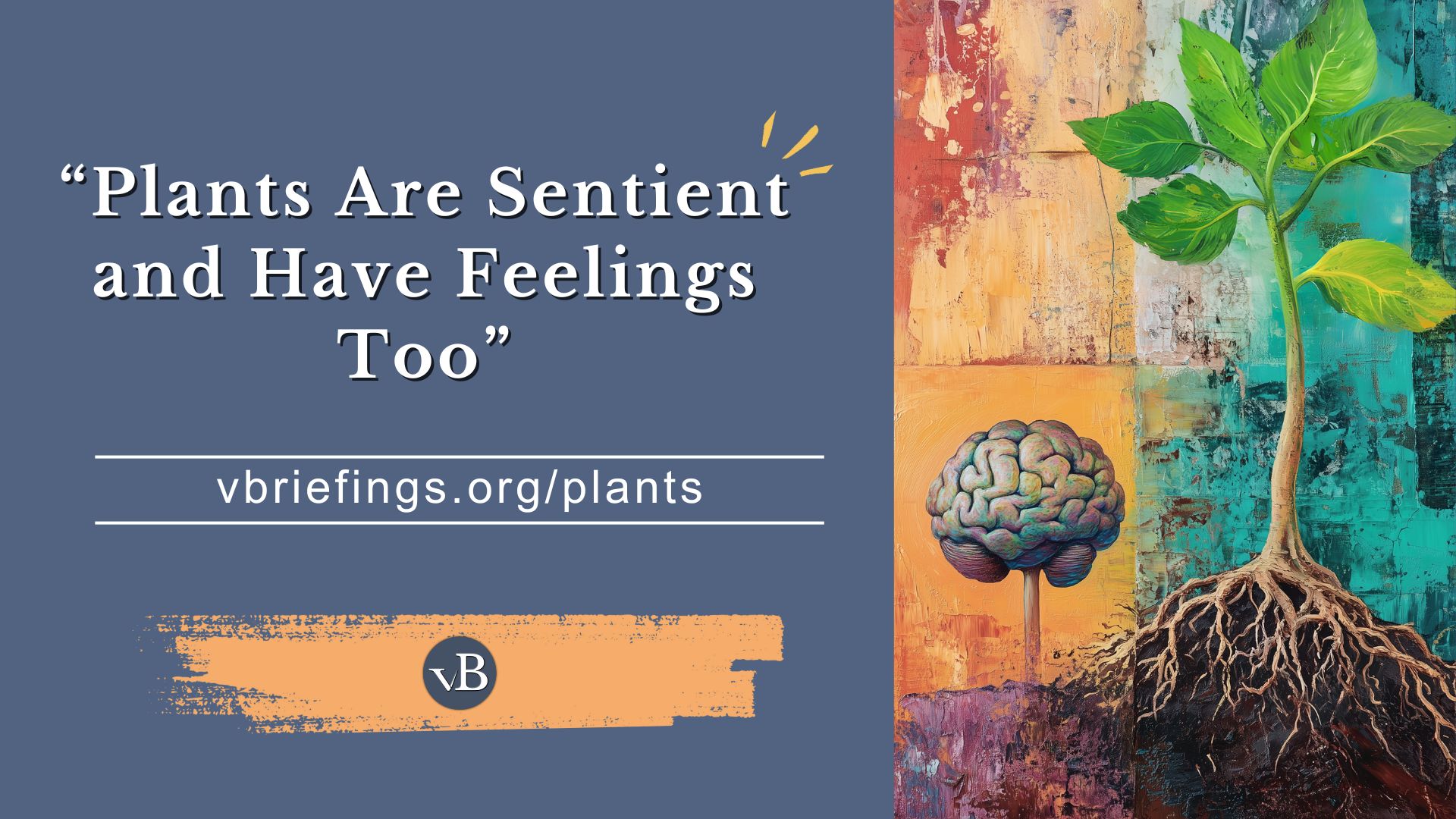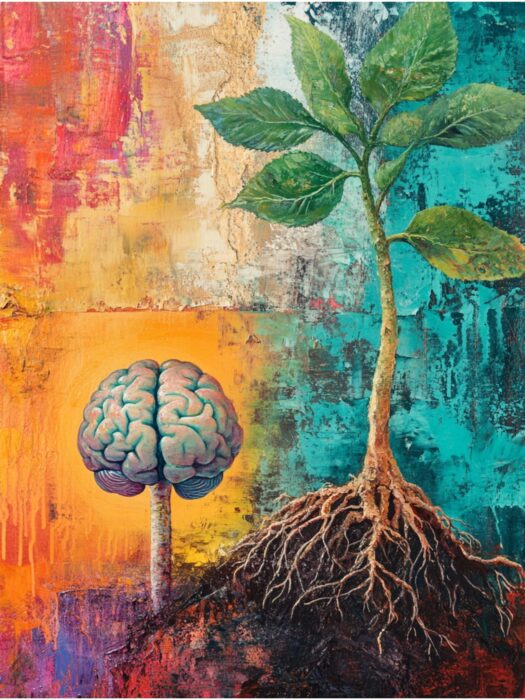Preface
Briefing description and more.
This briefing provides several reasons why objections to veganism based on plant sentience or plant pain are unfounded.
Companion Videos
How to use companion videos
Videos may be posted on multiple social media platforms, and you can share them on each platform according each platform’s conventions.
Share this Briefing
Social Media Sharing Image
This image will be used when sharing the briefing on a social media platform. You can see all social sharing images in the grid view.

How to share this briefing
Click on the icon for the platform on which you wish to share. What happens next depends on the platform, but generally a popup will appear, letting you add your own text as you share.
Briefing Meta
Metrics
Note: we will publish additional briefings after completing flashcards and presentation slides for selected briefings.
Counts:
| Main Text | |
| Key Points | 6 |
| Counterclaims | 2 |
| Supplementary | 2 |
| Further Study | 4 |
| Footnotes | 17 |
| Media & Advocacy | |
| Advocacy Notes | 7 |
| —Socratic Questions | 15 |
| Flashcards | 33 |
| Presentation Slides | 0 |
| Memes & Infographics | 0 |
| Companion Videos | 0 |
Other Meta:
Date Posted:
Last Edited:
Edit Log:
Key Points Links
Loading…
Help Us Improve
Please send your suggestions for improvements, or report any issues with this briefing to team@vbriefings.org
We appreciate that you are taking the time to help up improve. All suggestions and reports will be carefully considered.
Summary
A concise summary of the briefing (see below for citations).
The plant-sentience objection to veganism is flawed because plants lack the capacity to suffer or feel emotions, unlike animals, and eating animals causes more plant deaths than directly consuming plants due to agricultural inefficiency. While the idea of plant sentience is often sensationalized, it does not compare ethically or scientifically to the well-established actual sentience of animals.
Context
Places this topic in its larger context.
This objection to animal rights and veganism is usually not from a concern for the well-being of plants, but to illuminate a perceived inconsistency. If both plants and animals are sentient and have feelings, and if we abstain from eating animals for ethical reasons, then we must also abstain from eating plants.
Claims of plant sentience and intelligence make for provocative titles and seductive clickbait, but a closer consideration of the evidence renders these claims vacuous.
Key Points
This section provides talking points.
Eating animals kills more plants than eating plants.
Even if we assume that plants are sentient and can feel pain, eating plants directly would still cause less harm than eating animals. This is because raising animals for food is extremely inefficient: animals require large amounts of plant calories to produce a relatively small amount of edible animal calories.
- When you eat animal products, you’re not just consuming the animal’s body or secretions—you’re also indirectly consuming all the plants they were fed to produce that meat, dairy, or eggs.
- Due to the energy lost in metabolism and the need to grow non-edible parts (like bones, feathers, and skin),1 it takes on average 24 calories of plant feed to produce one calorie of food from animals (World Resources Institute, “Creating a Sustainable Food Future.”)2
- Over 75% of the world’s grains and soy used for food are fed to animals (United Nations and Our World in Data.)34
Plants differ from animals in ethically significant ways.
Plants don’t suffer or feel pain. Because plants lack a brain and pain receptors, they cannot feel pain. Plants may sense they are being eaten through mechanoreceptors, but they don’t care.5
Plants cannot experience emotions. Emotions are processed in the hippocampus and amygdala regions of the brain—neither of which are present in plants.6
Plants have no self-awareness or sense of the future. Thinking requires a brain, and without thought, there can be no self-awareness or sense of the future.
Plants do not have desires, preferences, or interests. These traits require thinking, and thinking requires a brain.
There is no reason plants would experience pain.
Because pain is a response to avoid tissue damage by withdrawing or fleeing, and since plants have limited ability to withdraw or flee, there is no reason they would have evolved to feel pain.7
Some plants depend on being eaten for the survival of their species.
Some plants depend on being eaten to enhance the chances that their species will survive. The indigestible seeds of the plants will be spread over a wide geographical area as the plants are eaten by animals and then deposited in the animals’ excrement.8
Visceral reactions differ between plants and animals.
At a less cerebral and more visceral level, I think we all sense the difference between pulling up a dandelion and slitting the throat of a chicken. Watching someone mow the lawn doesn’t evoke the same reaction as watching someone kick a dog. This visceral difference in reactions to harming plants versus animals shows we intuitively recognize animals’, not plants’, capacity to suffer.
Plants can act intelligently without being sentient.
Plants exhibit intelligence through complex behaviors like responding to stimuli, communicating chemically, and optimizing resource use. However, these are biochemical pathways, not neural pathways. Plants lack a brain and the capacity for subjective experiences, which are essential for sentience.9
Counterclaims
Responses to some yes but retorts.
Claim: You can’t prove that plants are not sentient, don’t feel pain, and don’t suffer.
The burden of proof is on the person making the claim. If I say that plants are sentient, for example, it’s up to me to prove that claim. Similarly, if I say unicorns are real, then the burden of proof is on me to offer evidence that they are real, not on you to prove that they are not.
Depending on how it’s pitched, this is known as the burden of proof fallacy10 or the argument from ignorance fallacy.11
- Burden of Proof Fallacy Example:
- “Plants are sentient, and if you disagree, you need to prove they aren’t.”
- This statement attempts to shift the burden of proof to others to disprove the claim instead of providing evidence to support the assertion that plants are sentient.
- Argument from Ignorance Fallacy Example:
- “No one has proven that plants aren’t sentient, so they must be.”
- Here, the claim is assumed to be true simply because there is no evidence proving it false, relying on a lack of disproof as evidence for the claim.
Related Quote: “What can be asserted without evidence can be dismissed without evidence”(Christopher Hitchens).12
Claim: There are numerous articles showing that plants are sentient, feel pain, and suffer.
Numerous articles claim plant sentience. Because plant sentience is a fascinating topic with widespread interest and curiosity, it lends itself to clickbait, sensationalism, and misrepresentation of findings.
Supplementary Info
Additional information that may prove useful.
Science Weighs In
A 2021 study published in Protoplasma, “Debunking a myth, plant consciousness” (mentioned in “Further Study” below), clarifies misconceptions and highlights the significant differences between animal and plant responses, reinforcing that plants do not have the capacity for consciousness in the way animals do. The main points are worth noting here:13
- “The controversial claim of classical Pavlovian learning in plants, even if correct, is irrelevant because this type of learning does not require consciousness.”
- “Plants have not been shown to perform the proactive, anticipatory behaviors associated with consciousness, but only to sense and follow stimulus trails reactively.”
- “Electrophysiological signaling in plants serves immediate physiological functions rather than integrative-information processing as in nervous systems of animals, giving no indication of plant consciousness.
Leonardo da Vinci Weighs In
It’s anecdotally interesting that Leonardo da Vinci realized hundreds of years ago that plants have no reason to feel pain. In one of his notebooks, he said:
- “Though nature has given sensibility to pain to such living organisms as have the power of movement,—in order thereby to preserve the members which in this movement are liable to diminish and be destroyed,—the living organisms which have no power of movement do not have to encounter opposing objects, and plants consequently do not need to have a sensibility to pain, and so it comes about that if you break them they do not feel anguish in their members as do the animals.”14
Further Study
Sources providing a deeper understanding of the topic or related topics.
Other Resources
The 2021 study published in Protoplasma, “Debunking a myth: plant consciousness” (mentioned in “Supplementary Info” above) critiques existing claims and misconceptions about plant consciousness and debunks the idea that plants possess sentience or conscious experience.15
This article by Sentient Media goes into more detail than this briefing in explaining that while plants can react to their environment through chemical and electrical responses, these reactions are fundamentally different from pain.16
“From Animal to Plant Sentience: Is There Credible Evidence?” by Heather Browning and Jonathan Birch (2023) examines the behavioral capacities of plants and assesses whether they are credible indicators of sentience. The authors conclude that, based on standards of evidence used in animal sentience research, the current behavioral evidence is insufficient to attribute sentience to plants.17
Advocacy Resources
Information to help with outreach and advocacy.
Note: we will publish additional briefings after completing flashcards and presentation slides for selected briefings.
Share This Briefing
Cloned from the Preface Section on page load.
Companion Videos
Cloned from the Preface Section on page load.
Memes and Infographics
No images found.
How to use Memes and Infographics
To sequence through all memes and infographics on this page, click on any image than use the arrow keys or the arrow buttons to show next and previous images.
To share a meme or infographic, right click on the image and choose download or save as. Then upload the image to the platform of choice.
Presentation Slides
How to Use the Presentation Slides
You can view the slideshow full screen by clicking on the first link above.
To use Canva presenter mode, view the speaker notes, or download the slides as PowerPoint, login to Canva (the free account works) and follow the Full Canva Link provided above.
To copy this presentation to your own Canva project, use the Full Canva Link provided above, then select File->Make a Copy from the upper left. You can build your own unique presentation from multiple briefings by copying the presentation from each briefing and then building another presentation from the copied presentations.
Flash Cards
We partner with Brainscape because of their excellent features for learning. You will need to create a free Brainscape account to study the cards.
Go to Flash Cards: This will take you to a list of decks.
About Flash Cards and Brainscape
Flash cards are here to help you commit important facts and concepts in this briefing to memory.
In Brainscape, there is one deck for each briefing. You can study more than one deck at a time. Brainscape uses spaced repetition to promote memory retention. It is “the secret to learning more while studying less.”
You can study using your browser, but Brainscape also has a free mobile app that makes learning anywhere easy.
Socratic Questions
Socratic-style questions are embedded in the Advocacy Notes below, and shown in italics.
These are open-ended, thought-provoking questions designed to encourage critical thinking, self-reflection, and deeper understanding. They are inspired by the Socratic method, a teaching technique attributed to the ancient Greek philosopher Socrates, who would ask his students probing questions rather than directly providing answers.
The goal is to help people examine their beliefs, clarify their thoughts, uncover assumptions, and explore the evidence and reasoning behind their ideas.
Advocacy Notes
Tips for Advocacy and Outreach
Segue the Conversation Back to Animal Ethics
People often bring up plant sentience not because they genuinely care about plants, but as a way to dismiss veganism. Instead of getting sidetracked into a debate about plant consciousness, redirect the conversation back to ethics.
- “Are you bringing this up because you really believe plants suffer, or are you using it to justify eating animals?”
- “Even if we assumed plants could suffer, we’d still have to ask: why add even more suffering by eating animals?”
- “If avoiding harm matters, wouldn’t it make sense to avoid the suffering we know exists rather than worrying about hypothetical suffering?”
Why? This keeps the focus on ethics instead of letting them use this argument as a distraction.
Show Them That Eating Plants Kill More Plants than Eating Animals.
Instead of debating whether plants feel pain, redirect the conversation to harm reduction.
- “Even if plants could feel pain, eating animals causes more plant deaths because running calories through animals is inefficient. Wouldn’t it make more sense to eat plants directly and cause less harm?”
- “If you’re concerned about plant suffering, wouldn’t the most plant-friendly diet be a vegan diet, since it requires fewer plants to sustain us than eating animals that have been fed plants?”
Why? This turns their argument against them—instead of disproving plant sentience, it shows that veganism still aligns with their supposed concern.
Challenge Their Assumptions About Sentience
People assume that because plants react to stimuli, they must be sentient. But that’s not how sentience works.
- “Yes, but those are biochemical pathways, not neural pathways—there’s a big difference.”
- “Plants can respond to light and gravity, but so can bacteria and fungi—do you think mushrooms have feelings?”
- “How could plants feed plan when they don’t have a brain or pain receptors?”
Why? This highlights the difference between reaction and sentience, making their argument fall apart.
Flip Their Belief Against Their Argument
People instinctively treat plants and animals differently—because they know plants aren’t sentient.
- “If you saw someone mowing the lawn and someone else kicking a dog, would you feel the same way about both?”
- “No one protests salad bars. But we all recognize slaughterhouses as places of suffering. Doesn’t that tell you something?”
Why? This appeals to their own moral instincts instead of just facts.
Expose the Moral Irrelevance of the Argument
Even if we pretended plants could suffer, would that justify harming animals?
- “If a tree could feel pain, would that make it okay to stab a pig?”
- “We know for certain that animals suffer. Even if plants did too, why would that justify causing even more suffering by eating animals?”
Why? This shows how illogical their argument is—even if plants could suffer, it wouldn’t justify harming animals.
Cause Them to Question Their Own Assumptions
Most people have never thought critically about this claim.
- “There’s no credible evidence that plants suffer, but overwhelming evidence that animals do. So why are we pretending these are equal?”
Why? This challenges them to rethink their position, rather than just sticking to a lazy talking point.
Keep the Focus on Ethics, Not Abstract Philosophy
This argument distracts from the real issue—our moral responsibility toward animals.
- “Even if plants suffered, we’d still be faced with a choice: cause less harm or cause more. Why not choose less?”
- “The real question is: if we can thrive without harming animals, why wouldn’t we?”
Why? This redirects the conversation to ethics, where their argument collapses.
Footnotes
Our sources, with links back to where they are used.
- James Rowe and John Nolan, Energy Requirements of Livestock. The Theory and Practice of Animal Nutrition, Applied Animal Nutrition Journal 2009 ↩︎
- The 24 to 1 figure was calculated from the table on page 37, figure 2, by averaging the ratios of calories in to calories out among the different animal products. For example, pigs consume 10 calories to get one calorie of pork out (100/10). If you average beef (100), milk (14), shrimp (14), pork (10), chicken (9), fin fish (8), and egg (13), you get 24. If sheep and buffalo milk were included, the average would be even more concerning.. “Creating a Sustainable Food Future.” World Resources Institute, 2013-2014 ↩︎
- In the referenced report, under Markets at a Glance—Course Grains, the latest data shows 224.7 units of coarse grains were used for human food (food) and 864.3 units were used for animal food (feed). Therefore, a total of 1089 units in total were used for food, but 864.3 of those were fed to animals. This is over 79% of the total. Food Outlook. United Nations FAO. November 2022 ↩︎
- Soy, Our World in Data. Hannah Ritchie and Max Roser. 2020 ↩︎
- We Asked a Biologist If Plants Can Feel Pain.” Vice. Accessed July 26, 2017. https://www.vice.com/en_us/article/xd74nd/we-asked-a-botanist-how-sure-science-is-that-plants-cant-feel-pain-302 ↩︎
- Phelps EA. Human emotion and memory: interactions of the amygdala and hippocampal complex. Curr Opin Neurobiol. 2004 Apr;14(2):198-202. PMID: 15082325. ↩︎
- Draguhn, A., Mallatt, J.M. & Robinson, D.G. Anesthetics and plants: no pain, no brain, and therefore no consciousness. Protoplasma 258, 239–248 (2021). ↩︎
- Nevo O, Filla C, Valenta K, Schupp EW. What drives seed dispersal effectiveness? Ecol Evol. 2023 Aug 31;13(9):e10459. Accessed Nov 15, 2024. ↩︎
- Draguhn, A., Mallatt, J.M. & Robinson, D.G. Anesthetics and plants: no pain, no brain, and therefore no consciousness. Protoplasma 258, 239–248 (2021). ↩︎
- Hansen, Hans. “Fallacies (Stanford Encyclopedia of Philosophy).” Stanford.edu, 29 May 2015. Access 16 Nov 2024. ↩︎
- “Argument from Ignorance.” Lucid Philosophy. ↩︎
- Clark, Roy Peter. “A Tribute to Christopher Hitchens: How to Write like a Wise Guy – Poynter.” Poynter, 16 Dec. 2011. Accessed 16 Nov. 2024. ↩︎
- Mallatt, Jon, et al. “Debunking a Myth: Plant Consciousness.” Protoplasma, vol. 258, no. 3, 1 May 2021, pp. 459–476, Accessed 16 Nov. 2024. ↩︎
- da Vinci, Leonardo. Leonardo Da Vinci’s Note-Books: Arranged and Rendered into English with Introductions. Empire State Book Company, 1923, 120 ↩︎
- Mallatt, Jon, et al. “Debunking a Myth: Plant Consciousness.” Protoplasma, vol. 258, no. 3, 1 May 2021, pp. 459–476, Accessed 16 Nov. 2020. ↩︎
- Kim, Hemi. “Do Plants Feel Pain? How Do We Know That They Don’t?” Sentient Media, 17 Aug. 2022. ↩︎
- “From Animal to Plant Sentience: Is There Credible Evidence?” by Heather Browning and Jonathan Birch (2023) DOI
10.51291/2377-7478.1784 ↩︎




